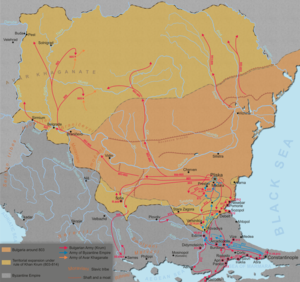Our website is made possible by displaying online advertisements to our visitors.
Please consider supporting us by disabling your ad blocker.
Battle of Versinikia
This article has multiple issues. Please help improve it or discuss these issues on the talk page. (Learn how and when to remove these messages)
|
| Battle of Versinikia | |||||||
|---|---|---|---|---|---|---|---|
| Part of the Byzantine–Bulgarian wars | |||||||
 Bulgaria under Khan Krum including the most important campaigns and battles | |||||||
| |||||||
| Belligerents | |||||||
| Bulgarian Empire | Byzantine Empire | ||||||
| Commanders and leaders | |||||||
| Kanasubigi Krum | Michael I Rangabe | ||||||
| Strength | |||||||
| 6,000–7,000[1] or 12,000[2] |
20,000[3]–30,000[2] 30,000–36,000[4] | ||||||
| Casualties and losses | |||||||
| Unknown | 2,000–3,000[5] | ||||||
The Battle of Versinikia (Bulgarian: Битката при Версиникия; Greek: Μάχη της Βερσινικίας) was a battle fought in 813 between the Byzantine Empire and the Bulgarian Empire, near the city of Adrianople (Edirne), in modern-day Turkey.
The Bulgarian army, led by Krum of Bulgaria, defeated the Byzantine forces. Following the defeat, Michael I Rangabe abdicated, with Leo V the Armenian taking the Byzantine throne.[6] The battle strengthened the Bulgarian position after their victory over Nikephoros I two years earlier. After the battle, the Bulgars controlled the whole region of Eastern Thrace (until the Byzantine–Bulgarian Treaty of 815), with the exception of a few castles that remained in Byzantine control. Krum died at the height of the preparations for the final siege of Constantinople on 13 April 814.
- ^ Panos, p. 37
- ^ a b Haldon 2001, pp. 76–77
- ^ Panos, p. 237
- ^ Hupchick, p. 96
- ^ Hupchick, p. 101
- ^ LUTTWAK, EDWARD N. (2009-11-15). The Grand Strategy of the Byzantine Empire. Harvard University Press. doi:10.2307/j.ctvjhzrf5. ISBN 978-0-674-05420-2.
Previous Page Next Page


